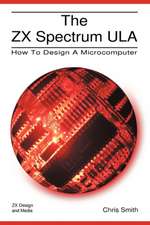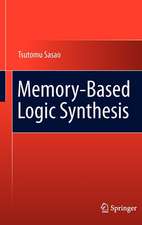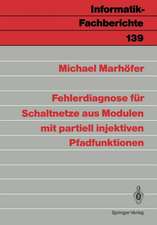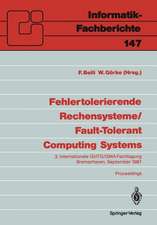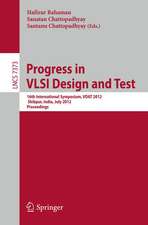Logic Synthesis and Optimization: The Springer International Series in Engineering and Computer Science, cartea 212
Editat de Tsutomu Sasaoen Limba Engleză Paperback – 5 oct 2012
| Toate formatele și edițiile | Preț | Express |
|---|---|---|
| Paperback (1) | 921.86 lei 6-8 săpt. | |
| Springer Us – 5 oct 2012 | 921.86 lei 6-8 săpt. | |
| Hardback (1) | 926.28 lei 6-8 săpt. | |
| Springer Us – 31 ian 1993 | 926.28 lei 6-8 săpt. |
Din seria The Springer International Series in Engineering and Computer Science
-
 Preț: 119.98 lei
Preț: 119.98 lei - 24%
 Preț: 1041.94 lei
Preț: 1041.94 lei - 20%
 Preț: 422.80 lei
Preț: 422.80 lei -
 Preț: 206.35 lei
Preț: 206.35 lei - 20%
 Preț: 313.25 lei
Preț: 313.25 lei - 20%
 Preț: 625.07 lei
Preț: 625.07 lei - 23%
 Preț: 637.95 lei
Preț: 637.95 lei - 18%
 Preț: 1190.42 lei
Preț: 1190.42 lei - 18%
 Preț: 937.34 lei
Preț: 937.34 lei - 20%
 Preț: 627.60 lei
Preț: 627.60 lei - 18%
 Preț: 921.55 lei
Preț: 921.55 lei - 20%
 Preț: 628.10 lei
Preț: 628.10 lei - 15%
 Preț: 619.21 lei
Preț: 619.21 lei - 20%
 Preț: 625.38 lei
Preț: 625.38 lei - 18%
 Preț: 921.99 lei
Preț: 921.99 lei - 20%
 Preț: 626.01 lei
Preț: 626.01 lei - 20%
 Preț: 966.36 lei
Preț: 966.36 lei - 20%
 Preț: 627.46 lei
Preț: 627.46 lei - 18%
 Preț: 919.68 lei
Preț: 919.68 lei - 20%
 Preț: 966.99 lei
Preț: 966.99 lei - 18%
 Preț: 929.52 lei
Preț: 929.52 lei - 20%
 Preț: 626.50 lei
Preț: 626.50 lei - 15%
 Preț: 630.93 lei
Preț: 630.93 lei - 18%
 Preț: 922.94 lei
Preț: 922.94 lei - 18%
 Preț: 1186.29 lei
Preț: 1186.29 lei - 18%
 Preț: 930.14 lei
Preț: 930.14 lei - 15%
 Preț: 625.55 lei
Preț: 625.55 lei - 18%
 Preț: 921.25 lei
Preț: 921.25 lei - 18%
 Preț: 920.17 lei
Preț: 920.17 lei - 20%
 Preț: 1247.75 lei
Preț: 1247.75 lei
Preț: 921.86 lei
Preț vechi: 1124.21 lei
-18% Nou
Puncte Express: 1383
Preț estimativ în valută:
176.41€ • 185.01$ • 147.10£
176.41€ • 185.01$ • 147.10£
Carte tipărită la comandă
Livrare economică 08-22 ianuarie 25
Preluare comenzi: 021 569.72.76
Specificații
ISBN-13: 9781461363811
ISBN-10: 1461363810
Pagini: 392
Ilustrații: XV, 375 p.
Dimensiuni: 155 x 235 x 21 mm
Greutate: 0.55 kg
Ediția:Softcover reprint of the original 1st ed. 1993
Editura: Springer Us
Colecția Springer
Seria The Springer International Series in Engineering and Computer Science
Locul publicării:New York, NY, United States
ISBN-10: 1461363810
Pagini: 392
Ilustrații: XV, 375 p.
Dimensiuni: 155 x 235 x 21 mm
Greutate: 0.55 kg
Ediția:Softcover reprint of the original 1st ed. 1993
Editura: Springer Us
Colecția Springer
Seria The Springer International Series in Engineering and Computer Science
Locul publicării:New York, NY, United States
Public țintă
ResearchCuprins
1 A New Exact Minimizer For Two-Level Logic Synthesis.- 1.1 Introduction.- 1.2 Notation.- 1.3 The Minimum Canonical Cover.- 1.4 Obtaining the Minimum Canonical Cover.- 1.5 Generating the Minimum Cover From the Minimum Canonical Cover.- 1.6 Heuristic Minimization Procedures.- 1.7 Experimental Results.- 1.8 Related Work.- 2 A New Graph Based Prime Computation Technique.- 2.1 Introduction.- 2.2 Definitions and Notations.- 2.3 The IPS Representation.- 2.4 Prime Computation of Boolean Functions.- 2.5 Prime Computation of Boolean Vectorial Functions.- 2.6 Experimental Results.- 2.7 Conclusion.- 3 Logic Synthesizers, The Transduction Method And Its Extension, Sylon.- 3.1 Introduction.- 3.2 Transduction Method.- 3.3 Logic Design of MOS Networks.- 3.4 New Logic Synthesis System, SYLON.- 3.5 Conclusions.- 4 Network Optimization Using Don’t-Cares And Boolean Relations.- 4.1 Introduction.- 4.2 Multi-Level Combinational Networks.- 4.3 Permissible Functions, Don’t-Cares, and Boolean Relations.- 4.4 Minimization Using Don’t-Cares.- 4.5 Minimization Using Boolean Relations.- 4.6 Conclusion.- 5 Multi-Level Logic Minimization Of Large Combinational Circuits By Partitioning.- 5.1 Introduction.- 5.2 Boolean minimization.- 5.3 Partitioning for Boolean minimizers.- 5.4 Top-down application of two-way partitioning.- 5.5 Experimental results.- 5.6 Conclusions.- 6 A Partitioning Method For Area Optimization By Tree Analysis.- 6.1 Introduction.- 6.2 Logic Partition and Partial Collapsing.- 6.3 Partial Collapsing Based on Tree Structure Analysis.- 6.4 Logic Optimization.- 6.5 Algorithms.- 6.6 Experimental Results.- 6.7 Conclusions.- 7 A New Algorithm For 0-1 Programming Based On Binary Decision Diagrams.- 7.1 Introduction.- 7.2 Preliminaries.- 7.3 The Algorithm.- 7.4 Experimental Results.-7.5 Conclusions and Future Work.- 8 Delay Models And Exact Timing Analysis.- 8.1 Introduction.- 8.2 Ternary Delay Simulation and a Waveform Calculus.- 8.3 Delay Models.- 8.4 Combinational Timing Verification Under the XBDO Model.- 8.5 Combinational Timing Verification Under the XBD Model.- 8.6 Conclusions.- 9 Challenges To Dependable Asynchronous Processor Design.- 9.1 Introduction.- 9.2 System Timing Failures.- 9.3 Delay Models.- 9.4 Asynchronous Architecture.- 9.5 Asynchronous Control and Data Transfer.- 9.6 Logic Synthesis.- 9.7 Testing and Concurrent Checking.- 9.8 Metastability.- 9.9 Conclusions.- 10 Efficient Spectral Techniques for Logic Synthesis.- 10.1 Introduction.- 10.2 Transformation and Complexity of Boolean Functions.- 10.3 Efficient Spectral Methods for Logic Synthesis.- 10.4 Conclusion.- 11 Fpga Design by Generalized Functional Decomposition.- 11.1 Introduction.- 11.2 Generalized Functional Decomposition.- 11.3 Generalized Functional Decomposition using BDD.- 11.4 Design Method for LUT Networks.- 11.5 Experimental Results.- 11.6 Conclusions and Comments.- 12 Logic Synthesis With Exor Gates.- 12.1 Introduction.- 12.2 Design Method of AND-EXOR circuits.- 12.3 Simplification of AND-EXOR expressions.- 12.4 Design Method for AND-OR-EXOR circuits.- 12.5 Experimental Results.- 12.6 Conclusions and Comments.- 13 And-Exor Expressions and their Optimization.- 13.1 Introduction.- 13.2 Several Classes of AND-EXOR Expressions.- 13.3 Comparison of Complexity.- 13.4 Minimization of PSDKROs.- 13.5 Experimental Results.- 13.6 Conclusion.- 14 A Generation Method for Exor-Sum-of-Products Expressions Using Shared Binary Decision Diagrams.- 14.1 Introduction.- 14.2 Preliminaries.- 14.3 Algorithm.- 14.4 Experimental Results.- 14.5 Conclusion.- 15 A New Technology Mapping Method Based on Concurrent Factorization And Mapping.- 15.1 Introduction.- 15.2 Concurrent Factorization and Mapping.- 15.3 Process of Technology Mapping.- 15.4 Experimental Results.- 15.5 Conclusions and Future work.- 16 Gate Sizing For Cell-Based Designs.- 16.1 Introduction.- 16.2 Previous Works.- 16.3 The Theda.CBS System.- 16.4 Experimental Results.- 16.5 Summary and Future Works.- A About the Authors.
Recenzii
'....I would recommend this book to any graduate student, or practising digital system design engineer, who wishes to know more about the subject and perhaps even develop new algorithms of his or her own.' Microprocessors and Microsystems 18:8 1994






